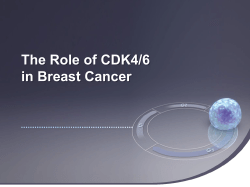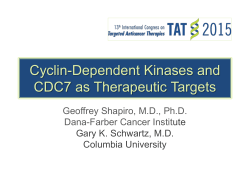
Co-targeting the CDK4/6 pathway in hormone receptor positive
Co-targeting the CDK4/6 pathway in hormone receptor positive breast cancer Valerie Malyvanh Jansen, MD, PhD Vanderbilt-Ingram Cancer Center Vanderbilt University May 1, 2015 This presentation is the intellectual property of the authors/presenters. Contact them at valerie.m.jansen@vanderbilt.edu for permission to reprint and/or distribute. Disclosure Information TOPS Annual Meeting 2015 • I have no financial relationships to disclose. - and – • I will not discuss off label use and/or investigational use in my presentation. 2 Resistance to endocrine therapy results in ER+ breast cancer deaths • More than 70% of breast cancers express the estrogen receptor (ER+). • Endocrine therapies aimed at targeting ERsignaling is the mainstay of treatment in ER+ breast cancer. – SERM (tamoxifen) – SERD (fulvestrant) – Aromatase inhibitors (letrozole, anastrozole, exemestane) • Up to 50% of ER+ breast cancers acquire resistance to therapy. – Gene amplification (HER2, FGFR1) – Gene mutations (PIK3CA, ESR1) American Cancer Society, Cancer Facts & Figures 2014 3 Targeting CDK4/6 in breast cancer • CDK4 is required for estrogenindependent ER+ breast cancer cell growth (Miller TW et al. Cancer Discov. 2011; 1 (4): 338-51.) • CDK4/6 inhibitors prevent the phosphorylation of pRb, thereby halting cell cycle progression in the G1 phase. • Palbociclib is FDA-approved for use in combination with letrozole for advanced ER+ breast cancer. • We utilized a kinome wide RNA interference screen to investigate genes: Ribociclib (LEE011) Palbociclib (PD-0332991) Abemaciclib (LY2835219) X 1. whose inhibition will increase sensitivity to CDK4/6 inhibition; 2. that are candidates for rational combination therapy. 4 Approach: RNA interference screen to identify sensitizers to CDK4/6 inhibition siNT siDEATH 5 Kinase screen identifies PDK1 as a determinant of sensitivity to CDK4/6 inhibition Ribociclib (LEE011) Palbociclib (PD-0332991) Abemaciclib (LY2835219) PDK1 = 3-phosphoinositide dependent protein kinase-1 [1] Rader J et al. Clin Cancer Res. 2013; 19(22): 6173-82. [2] Fry DW et al. Mol Cancer Ther. 2004; 3(11): 1427-1438. [3] Sanchez-Martinez et al. Mol Cancer Ther. 2011. Fry MJ. Breast Cancer Res. 2001; 3(5): 304-12. Lin HJ et al. Brit J Cancer. 2005; 93(12): 1372-81. 6 RNAi-mediated knockdown of PDK1 sensitizes ER+ breast cancer cells to CDK4/6 inhibition P 0.05 7 GSK2334470 is a highly specific inhibitor of PDK1 Medina J et al. J. Med. Chem. 2011:54 (6):1871–1895. 8 MCF-7 600 400 200 0 D G SK MS 23 O 34 4 LE 70 E0 G SK 1 1 Pa + L lb EE oc G SK icli +P b al bo Average Colony Number PDK1 inhibitor cooperates with CDK4/6 inhibitors in reducing ER+ BC cell proliferation LEE011 = CDK4/6i; GSK2334470 = PDK1i; Palbociclib = CDK4/6i 1500 1000 500 P 0.05 0 D G SK MS 23 O 34 4 LE 70 E0 G SK 11 Pa +L lb EE oc G SK icli +P b al bo Average Colony Number T47D 9 PDK1 is upregulated upon acute and long-term treatment with CDK4/6 inhibitor Long-term Treatment Acute treatment DMSO MCF-7 LEE011 [1µM] MCF-7 Hrs 0 0.5 1 2 6 12 24 48 72 P-Rb MCF-7/LR P-Rb EC50 0.05 µM PDK1 MCF-7 1.35 µM MCF-7/LR P-PDK1 P-S6 P-RSK2 P-p70S6K P-SGK3 Actin LEE011 [1µM] Cell viability (Fraction of CTL) PDK1 1.5 P-S6 1.0 ACTIN 0.5 0.0 -2 -1 0 1 log [M LEE011] 10 PDK1 inhibitor re-sensitizes LEE011-resistant cells to CDK4/6 inhibition 0.2 log [M inhibitors] • 50 2. 25 1. 64 50 2. 25 1. 0. 64 CIm = 0.62±0.02 0.0 32 50 2. 25 1. 64 0. 32 0. 16 0. 01 0.0 0.2 0. CIm = 0.58±0.12 0.4 16 0.2 0.6 0. 0.4 0.8 01 0.6 T47D/LR 1.0 0. 0.8 Cell viability (Fraction of CTL) T47D 1.0 0. GSK+LEE Cell viability (Fraction of CTL) LEE011 GSK2334470 0. log [M inhibitors] log [M inhibitors] DMSO 32 CIm = 0.46±0.04 0.0 16 2. 50 1. 25 0. 64 0. 32 0.0 CIm = 0.34±0.10 0. 16 0.2 0.4 0. 0.4 0.6 0. 0.6 0.8 01 0.8 MCF-7/LR 1.0 0. MCF-7 Cell viability (Fraction of CTL) Resistant 1.0 0. 01 Cell viability (Fraction of CTL) Parental log [M inhibitors] Mean combination index (CIm) <1 indicates synergy for the combination. LEE011 = CDK4/6i; GSK2334470 = PDK1i 11 PDK1 mediates resistance to CDK4/6 inhibitor independent of AKT GSK2334470 MCF-7 Xenografts BYL719 MCF-7/LR 1024 LEE011 Tumor Volume (mm3) MK2206 Vehicle (n=7) LEE011 (n=7) GSK2334470 (n=7) GSK+LEE (n=7) 512 256 128 P = 0.03 64 0 10 20 30 Days on treatment 40 12 Conclusions • Inhibition of PDK1 sensitizes ER+ breast cancer cells to CDK4/6 inhibition. • PDK1 is upregulated upon acute and long-term treatment with CDK4/6 inhibitor, LEE011, suggesting it is a mechanism of adaptation and/or resistance to inhibition of CDK4/6. • Combined inhibition of CDK4/6 and PDK1 synergistically inhibits proliferation of ER+ breast cancer cells. • This effect appears to be independent of AKT but temporally correlated with activation of other direct targets of PDK1. • Clinical trials of combination of CDK4/6 and PDK1 inhibitors are worthy of investigation in ER+ breast cancer. 13 Acknowledgements 14
© Copyright 2025









